Germany stretches from the chilly North Sea to the foothills of the Alps and the lakes of Switzerland, forming the enormous heartland of Central Europe. There are bustling cities dripping with history; magical woods; vineyards; gorgeous Baroque neighbourhoods; and some of the world’s most stunning castles within its boundaries. Look at this list of the top 15 places to visit in the country…
1. Berlin
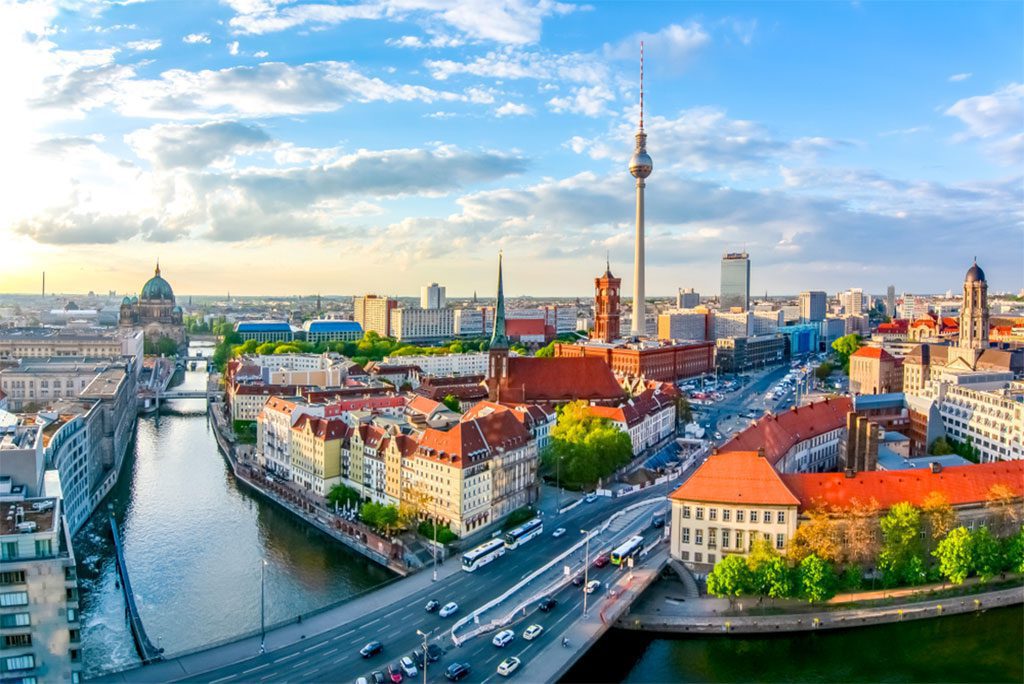
Berlin cityscape with Berlin cathedral and Television tower, Germany. Image source: Mistervlad/Shutterstock.com
Berlin is one of Europe’s uncontested must-see cities because it is cool, smart, cutting-edge, and packed to the very tip of its famous TV tower with culture, history, and character. At its core, Museum Island abounds with ancient artefacts retrieved from Babylon and Troy, while the darker stories of the 20th century may be found at locations like Checkpoint Charlie, the crumbling ruins of the Berlin Wall, and the magnificent Jewish Memorial by Peter Eisenman. The more traditional Reichstag, Brandenburg Gate, and summertime picnics in the Tiergarten are well counterbalanced by the bohemian centre of Friedrichshain-Kreuzberg, which is swamped with cafés, hip jazz clubs, ad hoc craft workshops, and creative galleries.
2. Neuschwanstein Castle
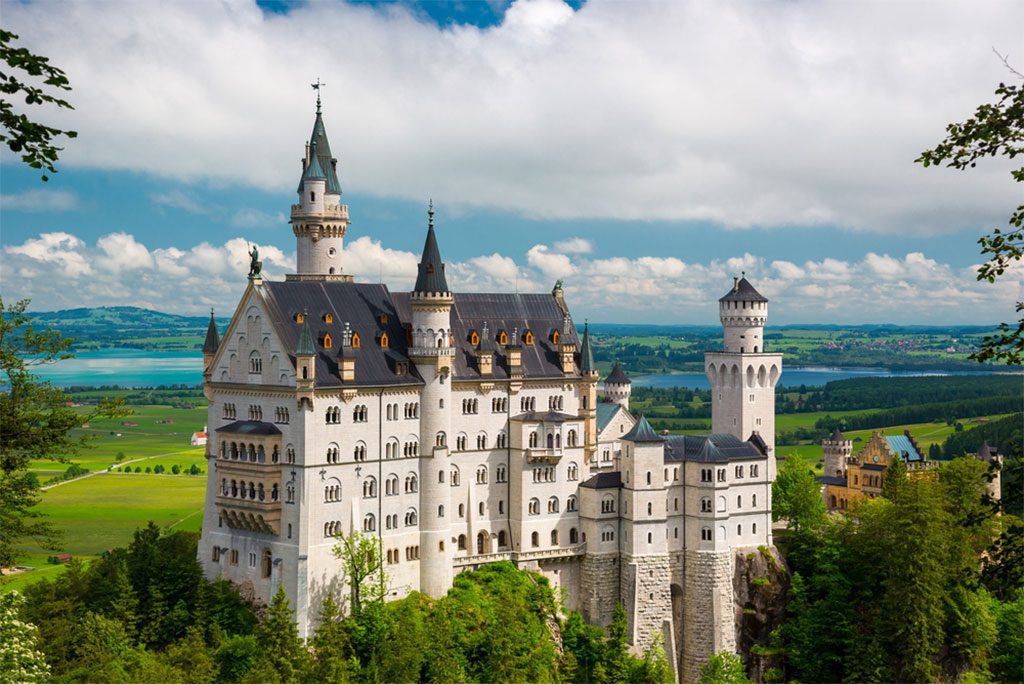
View of the famous tourist attraction in the Bavarian Alps, Neuschwanstein castle. Image source: Yury Dmitrienko/Shutterstock.com
Still standing tall on the jagged peaks of the German Alps is the huge Romantic heritage of Bavarian monarch Ludwig II. Neuschwanstein, positioned high above the picturesque village of Hohenschwangau, has been called the world’s most beautiful castle by many. It is easy to understand why the complex inspired both Walt Disney and J.K. Rowling, with its seemingly endless turrets and towers, flying buttresses, and creaking drawbridges; inside, visitors can get a taste of the wealth and extravagance experienced by probably Bavaria’s most renowned ruler.
3. Munich
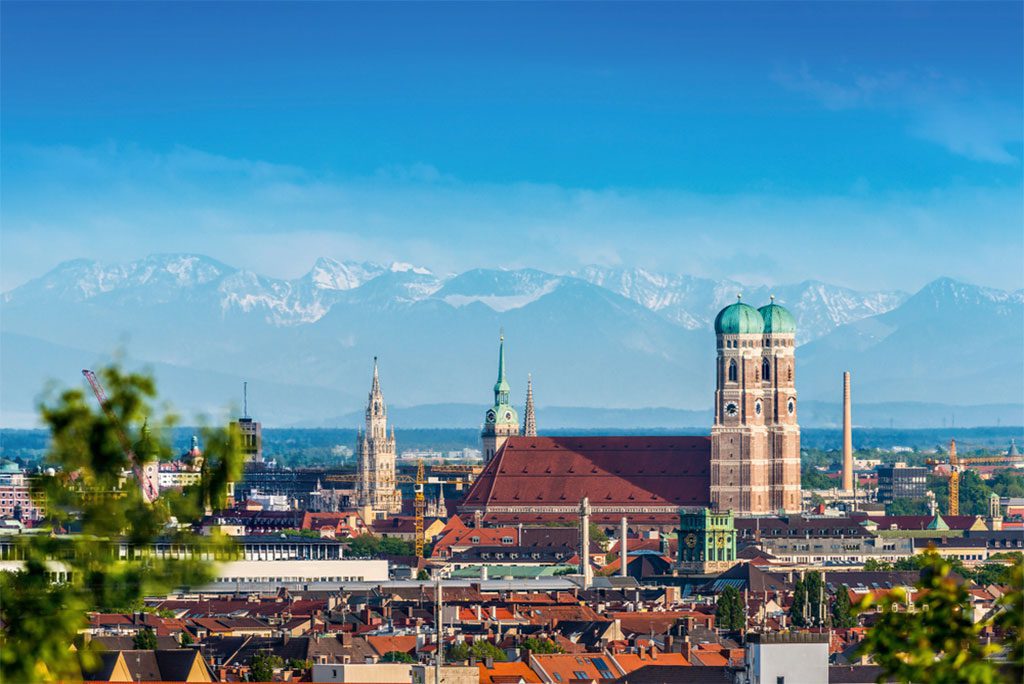
Munich Alps Panorama. Image source: engel.ac/Shutterstock.com
The beer-crazed, leather-obsessed, and hidden by the mountains Located in the southern part of Germany, Munich is a bustling city. Bavaria’s capital city is known for its uncompromising independence from the rest of Germany and for its strong personality. It’s all about the frothy wiessbier brewed to ancient Bavarian recipes, the smoky bratwurst, and finding some middle ground between the region’s tumultuous (Hitler tried the Beer Hall Putsch in 1923) and wealthy (Munich had a golden period at the height of the Bavarian rulers) pasts. The exquisite English Garden, the expansive Marienplatz, and the bob-topped domes of the Frauenkirche are just a few highlights of the town’s eclectic mix of mediaeval, stunning baroque, and lush parks. Stunning, to put it mildly!
4. Dresden
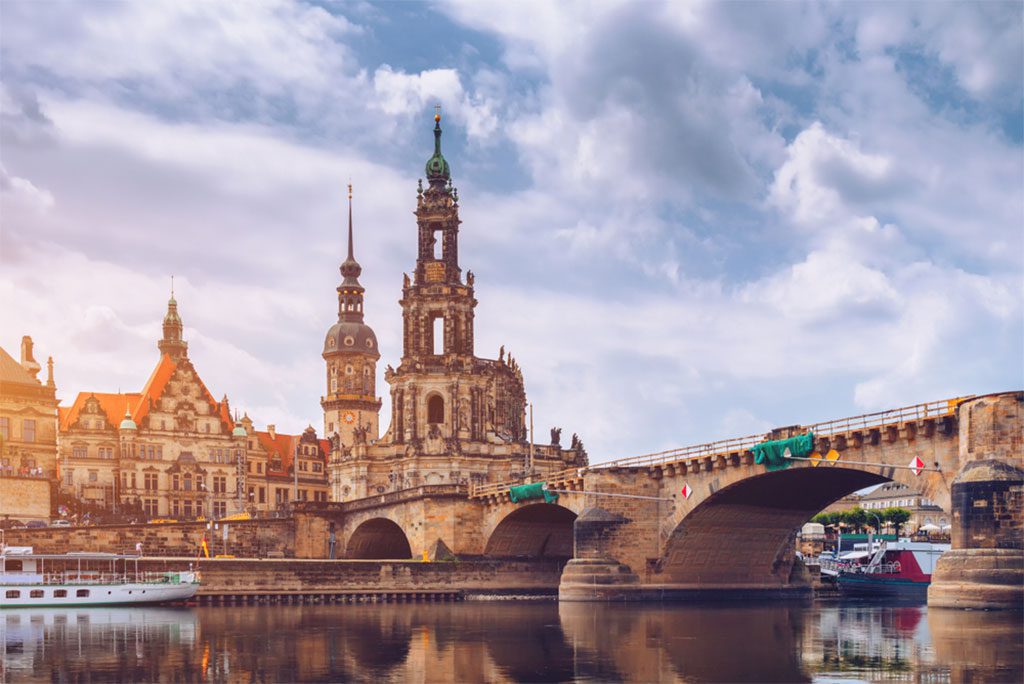
Dresden city skyline panorama at Elbe River and Augustus Bridge, Dresden, Saxony, Germany. Image source: DaLiu/Shutterstock.com
If I told you that Dresden, Germany, was almost wiped off the map during World War II, you wouldn’t believe me. Not with the Frauenkirche’s gleaming silhouette, the Zwinger Palace’s immaculate neoclassicism, and the enormous Semper Oper’s spotless facades clustered neatly along the Elbe’s windings as if they had not changed in decades. As a matter of fact, Dresden has benefited greatly from what is possibly Europe’s most extensive urban post-war rebuilding effort (sorry, Warsaw!). This has allowed this once mighty Saxon bastion to once again shine as the jewel of the German east.
5. Weimar
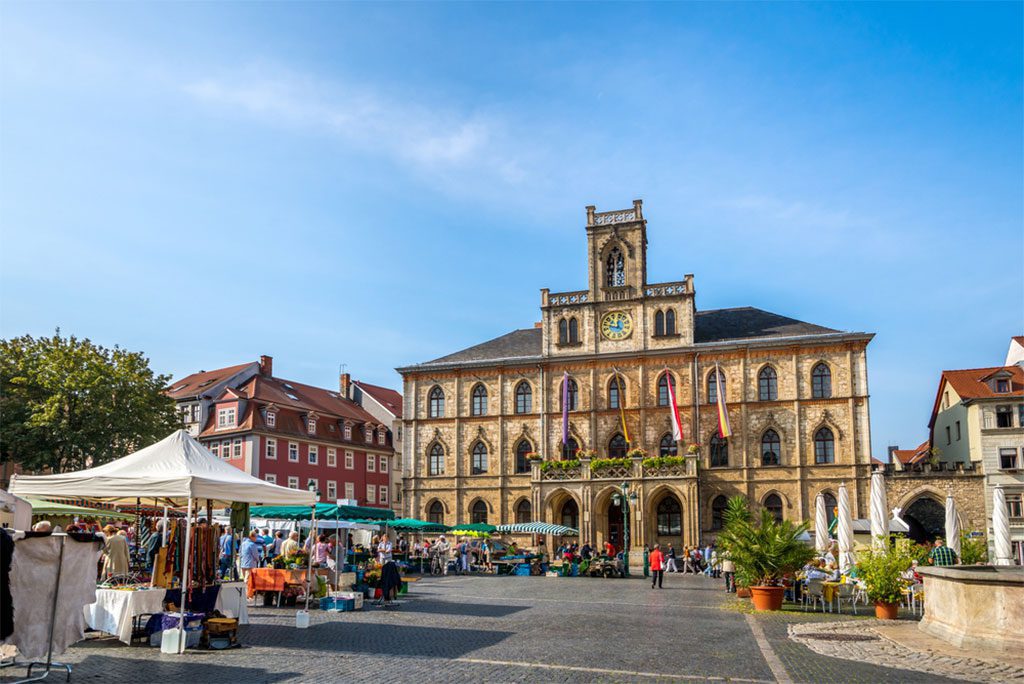
Weimar, Town Hall, Market Place. Image source: Sina Ettmer Photography/Shutterstock.com
As a result of Thuringia’s central location and its long history of intellectual excellence, the city of Weimar is filled to bursting with the spirits of geniuses who formerly lived there. Visitors may quickly get disoriented among the many magnificent sculptures of Goethe, effigies of the great philosopher Schiller, and halls where composers such as Liszt, Hummel, Bach, and Nietzsche would have worked. The influx of brilliant minds into Wiemar resulted in a building boom and the resulting rows of grand homes and ornately decorated facades on the town’s Wiemar Market Square. You may visit parks (great for strolling while reading about German philosophers) and sites associated with the founding of the Weimar Republic in 1918.
6. The Rhineland
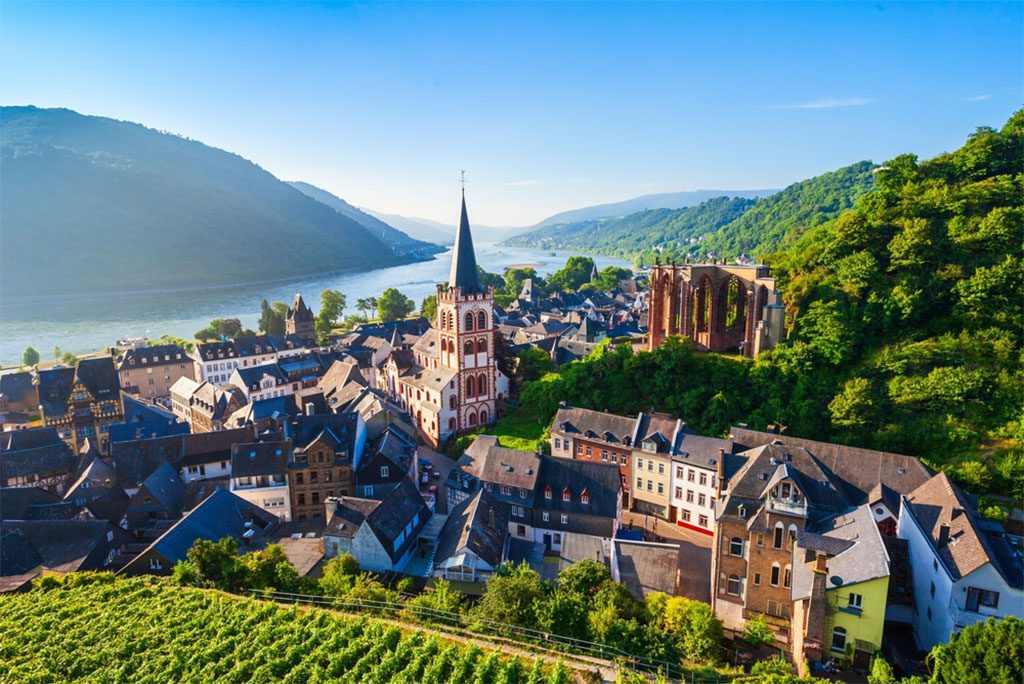
A scenic view of Bacharach town, located in the Rhine valley in Rhineland-Palatinate, Germany. Image source: saiko3p/Shutterstock.com
Some of the most beautiful castles and cultural settings in all of Germany may be found in the mythical region that clings to the winding channels of the River Rhine as it cuts its way through the West German highlands northward from Lake Constance. Historic settlements like Boppard, the mythical rocks of Loreley, 2,000-year-old Koblenz, and the fairy-tale tower tops of Eltz Castle may be seen along its journey. However, if you’re looking for the best wine in Germany, go no farther than the Rhineland. The Riesling and Spatburgunder grapes grown in the region, which cascade down the hillsides to the Mosel and Rhine rivers, are said to produce some of the best sweet whites and reds in Europe.
7. Berchtesgaden
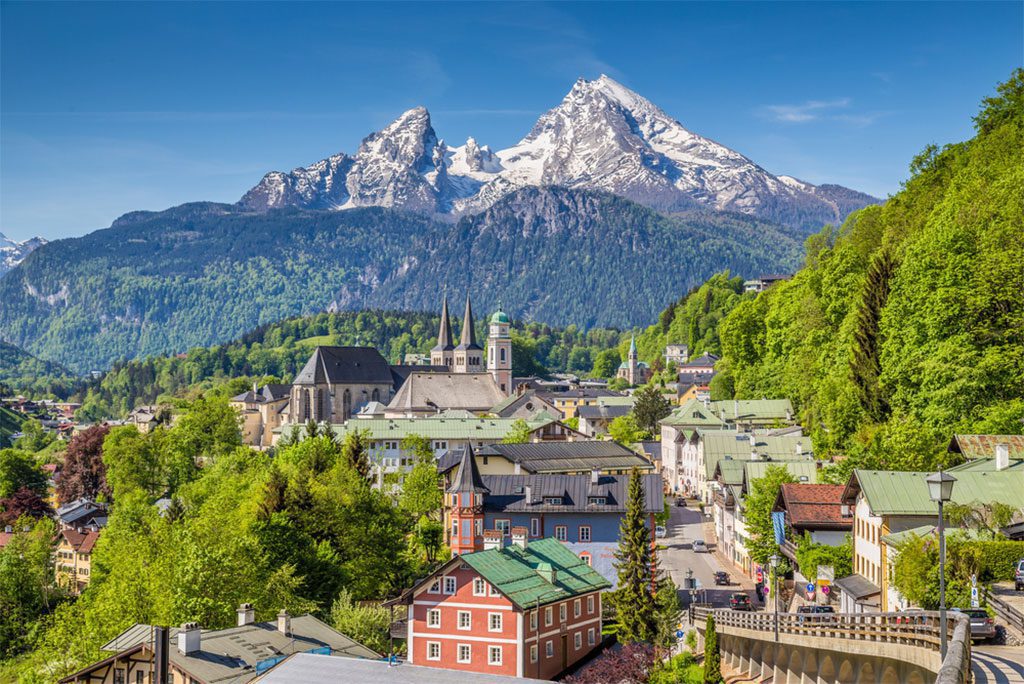
The historic town of Berchtesgaden, National park Berchtesgadener Land, Upper Bavaria, Germany. Image source: canadastock/Shutterstock.com
The tranquil Alpine enclave of Berchtesgaden is a great gem, especially as the seductive hill villages in these areas go, perched magnificently on the plateaus of the Bavarian highlands, only a stone’s throw from the Austrian border. Throughout the town’s historic core, carved wooden balconies spill over half-timbered houses; frescoed facades decorate the centre square; and the glistening waters of the Konigssee reflect the sunlight. High above the gingerbread-style town, between the robust corridors of the so-called Eagle’s Nest—Hitler’s former mountain hideaway with panoramic views of the Watzmann and pine-clad southern Bavaria—visitors may peek out at Berchtesgaden’s considerably darker history.
8. Heidelberg
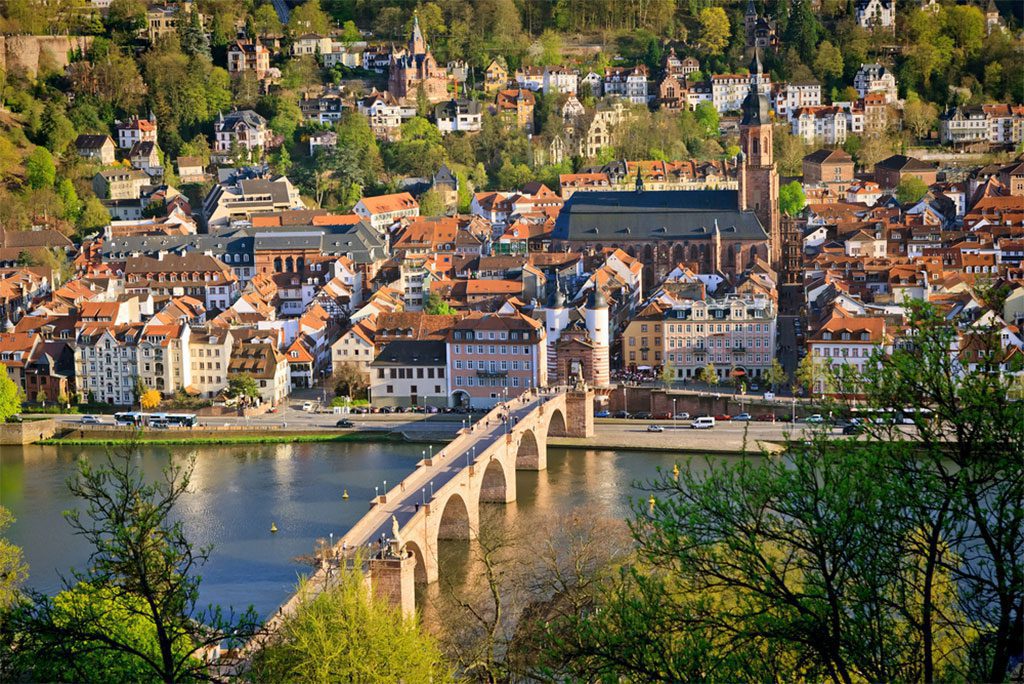
A beautiful view of Heidelberg in springtime, Germany. Image source: S.Borisov/Shutterstock.com
Heidelberg is a chocolate box town that rests on the ruins of a once-great mediaeval castle and is clustered around the picturesque River Neckar valley where it runs through the wooded hills in the heart of Baden-Württemberg. The Heidelberger Bergbahn funicular transports passengers to the citadel, which is perched high above the red-tiled rooftops and warren-hole lanes of the city’s Altstadt (Old Town), a beautiful region filled with bustling student pubs and vibrant music spots. This city hidden in the woods is one that you really must see, what with its gorgeous church tower, arched bridges, and the odd monument honouring Goethe and other German authors dotted throughout the centre.
9. Leipzig
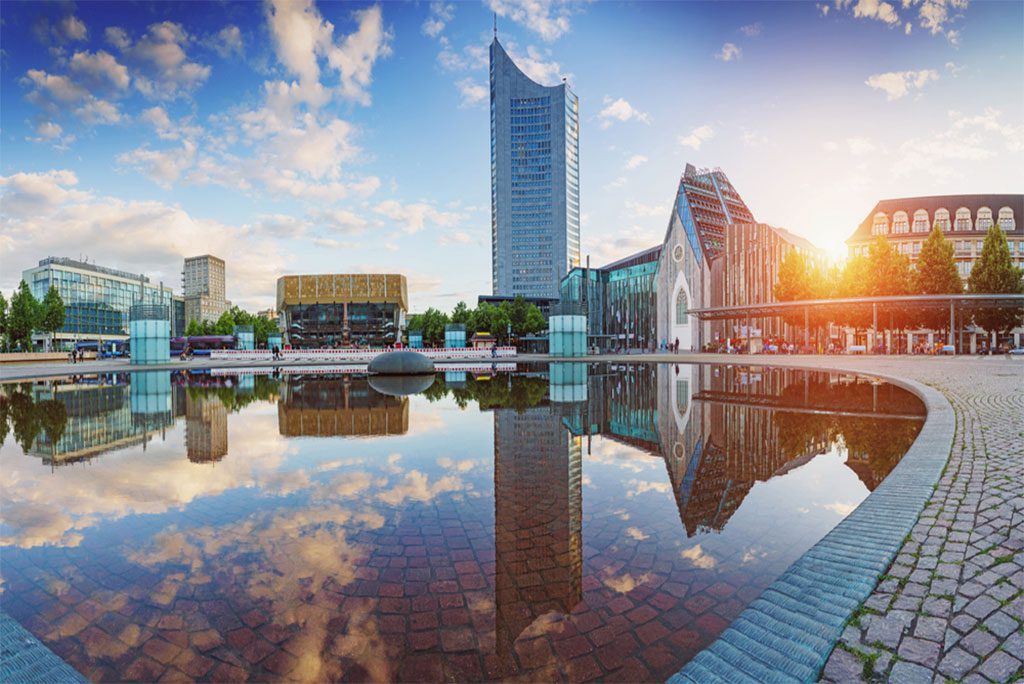
The cityscape of Leipzig, Germany. Image source: Igor Link/Shutterstock.com
Leipzig, with a population of over 500,000 and rising, is often regarded as Germany’s most exciting major city. The huge Renaissance Old Town Hall (the biggest in the nation), innumerable hotspots displaying the great German masters Goethe and Schiller, and one thriving underground sector driven by creative, bohemian types who have escaped the growing costs of the capital, all contribute to the city’s reputation as an artistic and historical rival to Berlin. In other words, clubs, bars, and ancient Saxon taverns dot the edges of sleepless Karl-Liebknecht-Strasse, the spot to come for a drink, while galleries and studios exist between the exquisite baroque opera buildings and Bach’s venerated sepulchre in the Thomaskirche.
10. Cologne
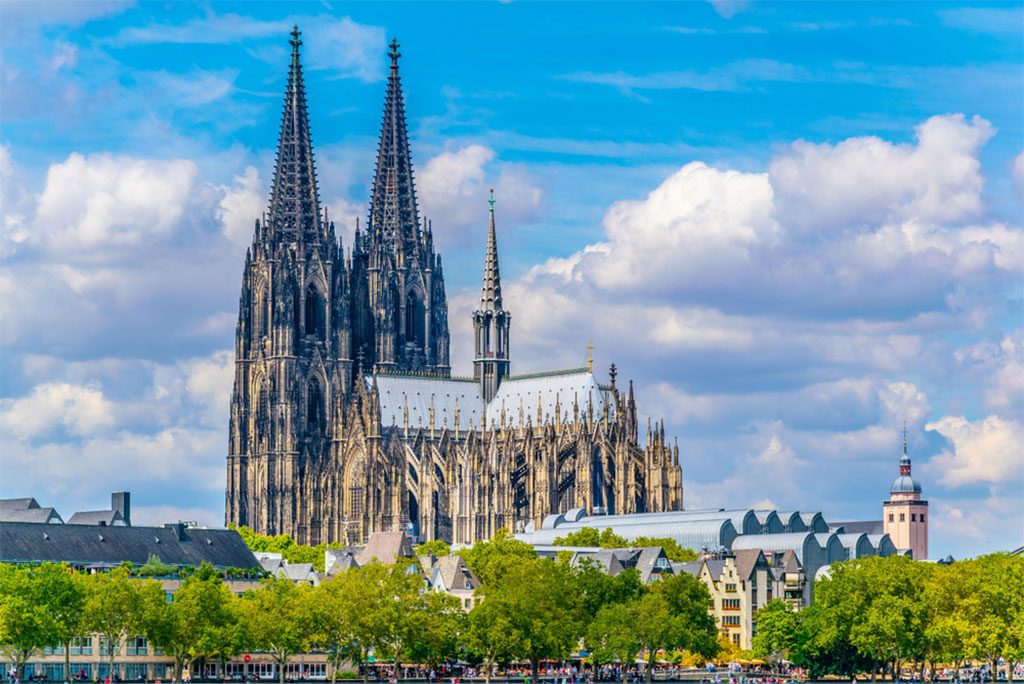
A close-up view of the stunning Cologne Cathedral in Germany. Image source: trabantos/Shutterstock.com
The liberal city of Cologne, Germany, is certainly one of the country’s must-see metropolises, and it is dominated on all sides by the towering Gothicism of the enormous Kolner Dom (itself a UNESCO World Heritage Site!). It is located on the Rhine-Ruhr between the post-industrial cities of Aachen and Bonn in northern Germany. The city’s history dates back to the Roman era, and its historic core is dotted with beautiful examples of Romanesque architecture. Though the Old Town’s picturesque half-timbered houses and cobblestone streets are a major draw for visitors, that’s just part of the tale. Cross the Rhine and visit Früh em Veedel, where residents may be seen drinking Kolsch beers, or the Agnesviertel, where you’ll find the omnipresent German hipster pubs and bohemian drinking holes.
11. Nuremberg
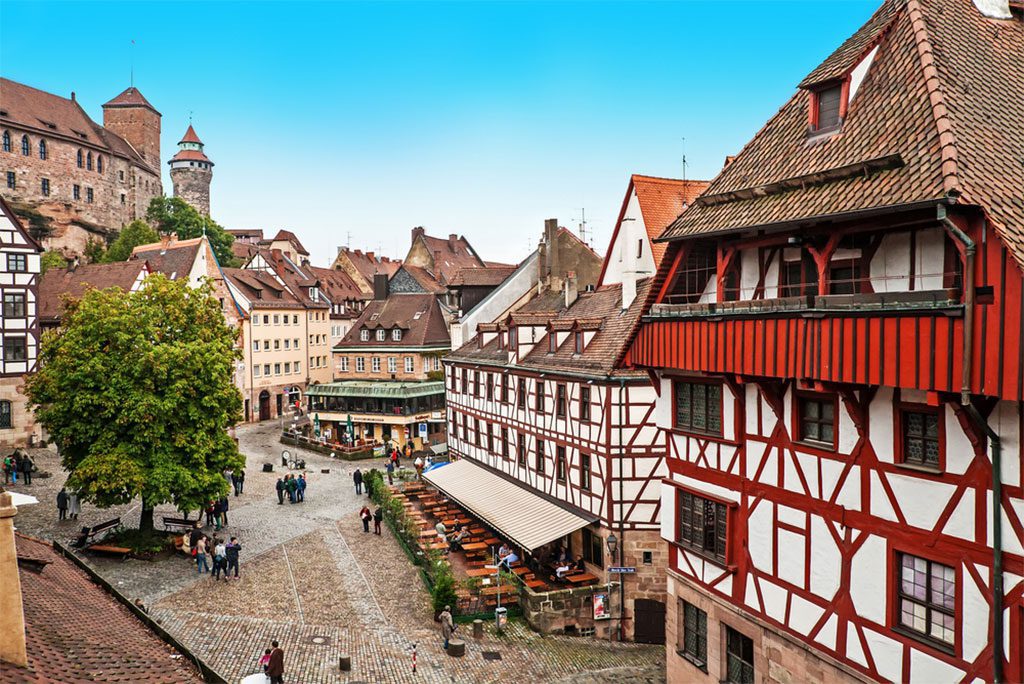
A stunning view of the cityscape of Nuremberg, Germany. Image source: Pani Garmyder/Shutterstock.com
Historic Nuremberg is competing with modern-day Munich as Bavaria’s main destination and is the ideal starting place for those who want to visit the state’s northern regions. And it sure does have a few surprises up its sleeve. Fortressed by the imposing bulwarks and keeps of Nuremberg Castle, this student-packed town was once the Holy Roman Empire’s epicentre and is now well recognised as one of Nazi Germany’s key administrative centres (and also the location of the post-war Nuremberg trials). Beer is excellent, famous throughout Germany for its dark colour and robust flavours, and the historic core has been preserved with half-timbered facades and tree-dotted cobblestone squares.
12. Rothenburg ob der Tauber
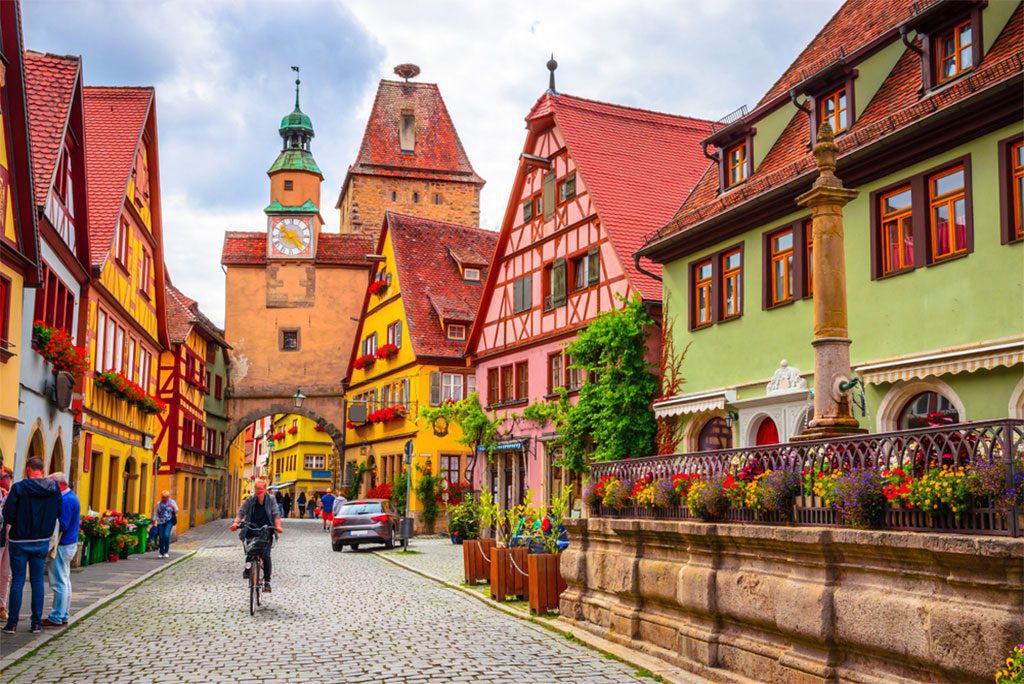
A picturesque view of the charming streets in Rothenburg ob der Tauber, Bavaria, Germany. Image source: Olena Znak/Shutterstock.com
Rothenburg ob der Tauber is the crowning glory of the so-called Romantic Road, a collection of castle ruins and mediaeval settlements stretching from Wurzburg into the depths of Bavaria. The highlight of the city is the Altstadt district, with its winding alleys and Bavarian half-timbered houses; dangling lampposts; pots of flowering bougainvillaea in the summer; arched entrances; and some of Europe’s most impressive defence walls from the 14th century. At the heart of it all is one picture-perfect marketplace square, surrounded by the bulbous domes of the town hall and bustling with local cafés and bars to boot.
13. The Black Forest
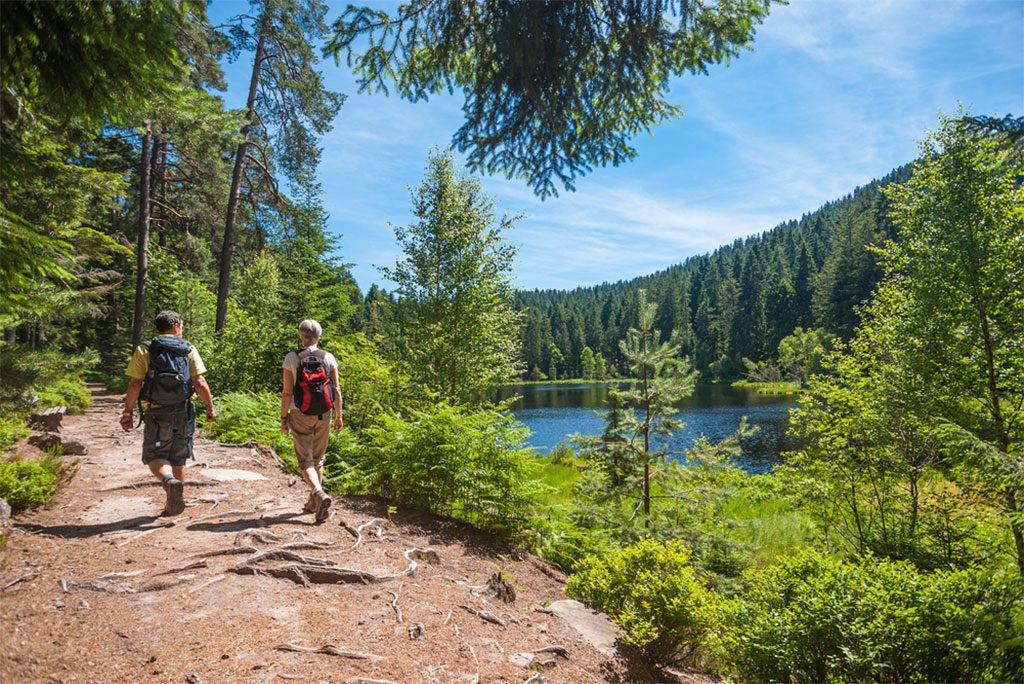
A group of hikers enjoying the scenery at the Herrenwieser See in the Black Forest, Baden-Wuerttemberg, Germany. Image source: Juergen Wackenhut/Shutterstock.com
The Black Forest is where Hansel and Gretel, Rapunzel, and other haunting, timeless fairy tales were written by the Brothers Grimm. It is in the south-western corner of Germany, near where France and Switzerland meet. The stunning wilderness contributes much to the region’s magnetic appeal, which is bolstered by its strategic location and legendary past. Starting at the Rhine, this undulates between granite peaks and river-carved valleys, oceans of oak and Scots pine, beech and Douglas firs, wild forests of old tree trunks, and leaf-strewn hiking pathways. Another option is Baden-Baden, which is a lovely and popular spa town with plenty of space for unwinding.
14. Hamburg
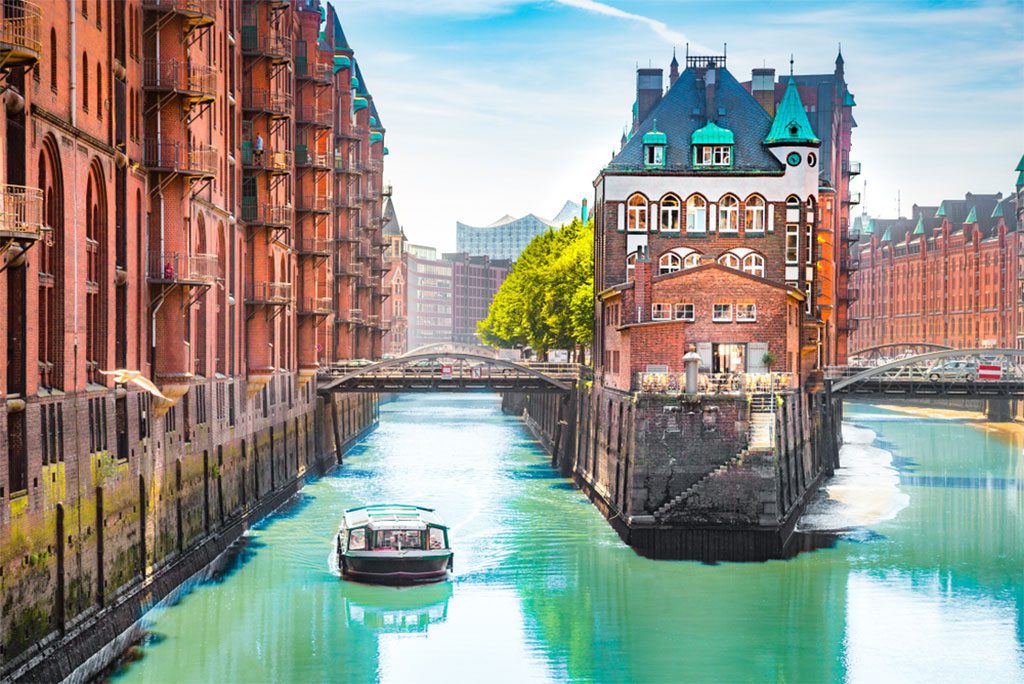
A classic view of the famous Speicherstadt warehouse district in Hamburg, Germany. Image source: canadastock/Shutterstock.com
The city of Hamburg beats with life. The biggest ports and harbours in Germany give it the prestigious moniker “Germany’s door to the world,” and the city also has an exciting mix of cultures and a strong economic foundation. Masterpieces such as the Hamburg Rathaus shine brightly in the city’s centre, while the seedy lanes and dark alleys of Reeperbahn in Sankt Pauli are known for their ostentatious strip joints and burlesque edge. Schanzenviertel, in the meantime, pulses with student life; its lively squares are filled with cafes in the Parisian manner; African world music; Chicago jazz; and vegan cuisine. Hamburg justifies its status as Germany’s second-largest city, yes sir!
15. Bamberg
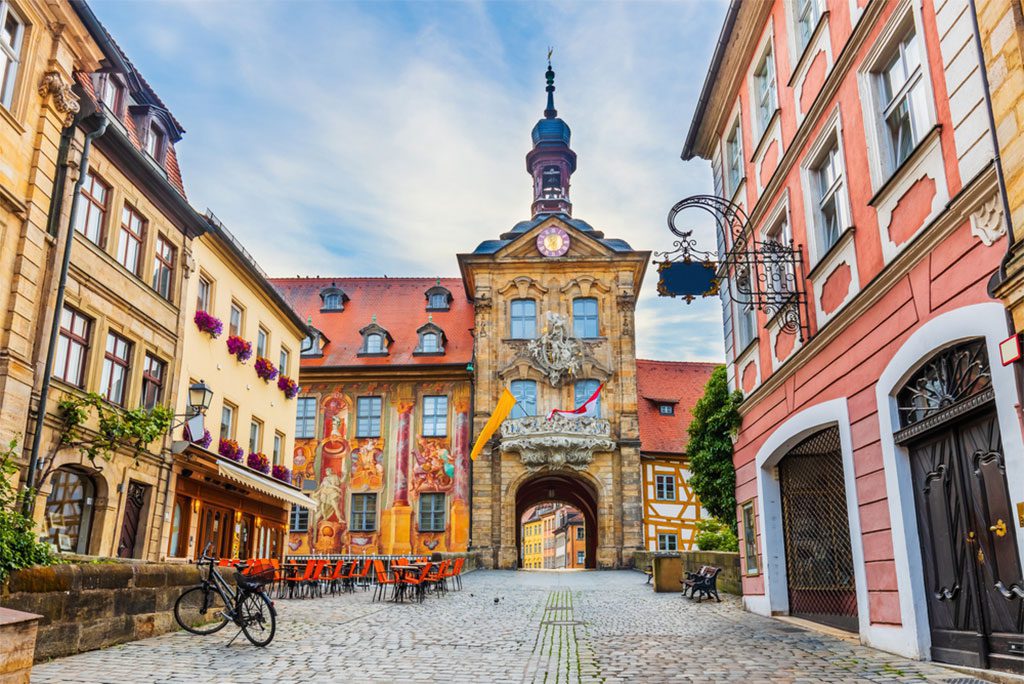
The historic Town Hall of Bamberg (Altes Rathaus), located in the heart of the city. Image source: SCStock/Shutterstock.com
Bamberg, located in the state of Bavaria, is a picturesque mediaeval town that is a beer lover’s paradise and a picture-perfect tourist destination. The Old Town area (a UNESCO World Heritage Site to boot) is split in two by the twin channels and canals of the Regnitz and the Main rivers, and is often regarded as the most beautiful spot in the nation. The breweries in this picturesque district draw students and tourists alike, with the pungent and unmistakable scents of Bamberg’s distinctive smoked beer fueling the lively conversation in the taverns.


